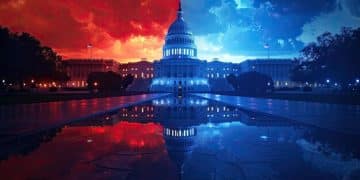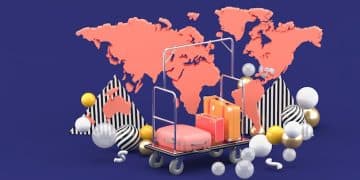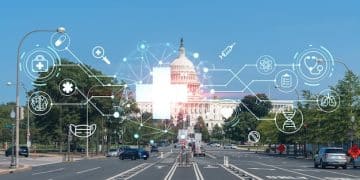Immigration Policy Changes & US Labor Market 2025: An Analysis

The proposed changes to immigration policy could significantly reshape the US labor market by 2025, potentially influencing workforce availability, wage dynamics, and sectoral growth across various industries.
As 2025 approaches, discussions around immigration policy in the United States invariably turn to their projected impact on the nation’s economic landscape. Understanding how will the proposed changes to immigration policy affect the US labor market in 2025 is crucial for businesses, policymakers, and workers alike, as these shifts could redefine labor availability and economic trajectories.
Understanding the Current Immigration Framework and its Economic Role
Before delving into future predictions, it is essential to grasp the fundamental interplay between current immigration policies and the US labor market. Immigration has historically been a cornerstone of American economic growth, supplying labor, fostering innovation, and contributing to consumer demand. The existing framework is a complex tapestry of visa categories, quotas, and regulations designed to manage flows of people entering the country for various purposes, including work, family reunification, and asylum.
The economic role of immigration is multifaceted. Immigrants fill critical labor gaps in sectors ranging from agriculture and construction to healthcare and technology. They often take on jobs that native-born workers may be less willing to do, or they possess specialized skills that are in high demand but short supply domestically. Furthermore, immigrants have higher rates of entrepreneurship, starting businesses at a faster pace than native-born individuals, thereby creating jobs and stimulating economic activity.
Key Components of US Immigration Policy
The current system is broadly categorized into several visa types, each with its own set of rules and numerical limitations. These categories dictate who can enter the country, for how long, and for what purpose. They include employment-based visas for skilled and unskilled workers, family-sponsored visas, and humanitarian programs for refugees and asylum seekers. Each component has an indirect but significant impact on the labor supply and demand within the US economy.
- Employment-Based Visas (e.g., H-1B, H-2A, O-1): Designed to meet specific labor needs, from engineers to seasonal agricultural workers.
- Family-Sponsored Immigration: While primarily focused on family reunification, these immigrants also enter the labor force, contributing to economic activity.
- Refugee and Asylum Programs: Provide humanitarian relief, with recipients eventually integrating into the labor market.
The mechanisms by which these policies affect the labor market include both direct and indirect channels. Direct effects stem from the number and skill sets of immigrants admitted. Indirect effects relate to broader economic impacts, such as consumer spending, innovation, and demographic shifts. A reduction or increase in any of these categories can send ripple effects throughout the economy, influencing wages, employment rates, and even the pace of technological advancement.
In essence, the current immigration framework is not merely a set of rules but a critical economic lever. Any proposed changes, whether subtle adjustments or sweeping overhauls, will inevitably recalibrate this lever’s position, leading to discernible impacts on the US labor market. Understanding this baseline is crucial for projecting the future landscape.
Proposed Policy Changes: A Spectrum of Possibilities
Discussions around proposed changes to immigration policy are dynamic and often contentious, reflecting diverse economic, social, and political viewpoints. For 2025, several broad categories of policy adjustments are likely to be debated, each with distinct implications for the US labor market. These changes could range from incremental adjustments to existing visa programs to fundamental overhauls of the entire immigration system.
One primary area of focus often involves the reallocation of visa quotas. For instance, proposals might seek to increase or decrease the number of employment-based visas (like the H-1B for high-skilled workers or the H-2A for agricultural workers) to address perceived labor shortages or surpluses in specific sectors. Such adjustments can significantly alter the supply of specialized labor or seasonal workers, directly impacting wage pressures and hiring capabilities in affected industries.
Potential Areas of Policy Reform
Several key areas of reform are consistently raised in policy discussions. Each carries a unique set of projected impacts on the labor market:
- Skill-Based Immigration Systems: Moving towards a system that prioritizes immigrants with specific skills or educational backgrounds, similar to models in Canada or Australia. This could attract more high-skilled workers but might reduce inflows of lower-skilled labor.
- Border Security and Enforcement Measures: Increased enforcement could deter undocumented immigration, potentially tightening labor supply in sectors heavily reliant on this workforce. Conversely, it could also push wages up in these sectors as competition for labor increases.
- Modernizing Visa Processes: Streamlining application procedures and reducing backlogs could make it easier and faster for needed workers to enter the country, improving labor fluidity.
Another significant factor is the potential for changes to legal immigration pathways. Proposals could include reforms to family-based immigration, potentially shifting towards a more employment-centric model. Such shifts could alter the demographic composition of new immigrants, thereby influencing the types of jobs they fill and their overall economic contributions.
Furthermore, policies related to asylum and refugee resettlement can also have labor market implications, especially for urban areas and specific industries that absorb these populations into their workforces. While these policies are primarily humanitarian, their scale and scope inevitably influence local labor supplies and demands. The current political climate suggests ongoing debates about the balance between economic needs, national security, and humanitarian concerns, all of which will shape the specifics of policy changes leading up to and impacting 2025.
Direct Impacts on Labor Supply and Demand
The most immediate and tangible effects of proposed immigration policy changes will be felt in the balance of labor supply and demand across various sectors of the US economy. Alterations to visa categories, quotas, and enforcement mechanisms can directly influence the availability of workers, which in turn affects employment rates, wage levels, and hiring practices.
An increase in the number of high-skilled visas, for example, would likely alleviate labor shortages in technology, healthcare, and scientific research fields. This influx of talent could lead to increased innovation, productivity gains, and potentially lower salaries for highly specialized roles due to increased competition. Conversely, a reduction in these visas could exacerbate existing shortages, driving up wages for skilled professionals and potentially pushing companies to seek talent abroad or reduce expansion plans within the US.
Sector-Specific Ramifications
The impact will not be uniform across all industries. Some sectors are inherently more reliant on immigrant labor than others:
- Agriculture: Heavily dependent on seasonal and often immigrant labor (e.g., H-2A visa holders). Stricter immigration policies could lead to labor shortages, increased production costs, and potentially higher food prices.
- Construction: A significant portion of the construction workforce is foreign-born. Policy changes could affect project timelines, labor costs, and housing affordability.
- Hospitality and Services: Many entry-level and service positions are filled by immigrants. Reduced immigration could lead to labor scarcity in these areas, impacting service quality and raising wages in a sector with historically lower pay.
For low-skilled labor, stricter policies or reduced immigration could lead to a tighter labor market, potentially pushing wages higher for these positions. While this might be seen as beneficial for some domestic workers, it could also increase operational costs for businesses, potentially leading to automation or outsourcing.
Conversely, more lenient or expansive immigration policies could increase the overall labor supply, potentially exerting downward pressure on wages across various skill levels. This scenario might favor employers seeking to expand or maintain lower labor costs, but it could also raise concerns about competition for jobs among native-born workers and recent immigrants. The specific design of any policy change will dictate whether the emphasis lies on attracting high-skill talent, addressing general labor shortages, or enhancing border security, each yielding a distinct set of supply-side and demand-side labor market outcomes.
Wage Dynamics and Employment Rates
The discussion of how proposed immigration policy changes will affect the US labor market in 2025 inevitably leads to an examination of wage dynamics and overall employment rates. The relationship between immigration, wages, and employment is complex and has been the subject of extensive economic debate. While there are varying viewpoints, general economic principles suggest that changes in labor supply can influence these key indicators.
If immigration policies tighten, leading to a reduction in the influx of foreign-born workers, the supply of labor in certain sectors will decrease. According to basic supply and demand economics, a lower supply of labor, given consistent demand, tends to put upward pressure on wages. This effect might be most pronounced in sectors heavily reliant on immigrant labor, such as agriculture, construction, and certain service industries. While higher wages could benefit existing workers in these sectors, they could also increase operational costs for businesses, potentially leading to higher consumer prices or shifts towards automation to mitigate labor expenses.
Analyzing Wage Impacts Across Skill Levels
The impact on wages is also likely to vary based on skill level. For high-skilled professions, an increase in employment-based visas could introduce more competition, potentially stabilizing or even slightly reducing wage growth. Conversely, a decrease in these visas could lead to significant wage increases for highly specialized personnel due to intensified competition among employers for scarce talent. For entry-level or low-skilled positions, reduced immigration might lead to upward wage adjustments, as employers may need to offer more competitive pay to attract a smaller pool of available workers.
Regarding employment rates, the effects are equally nuanced. A significant reduction in immigration could lead to labor shortages in some sectors, potentially slowing economic growth if businesses cannot find sufficient workers to meet demand. While this might, in theory, create more opportunities for native-born workers in certain segments, it could also lead to a decline in overall economic activity and job creation if businesses are forced to scale back or move operations. On the other hand, a more open immigration policy could boost labor supply, potentially alleviating shortages and supporting business expansion, which could indirectly lead to lower unemployment rates by fostering faster economic growth.
Furthermore, the dynamic often depends on the elasticity of labor demand and supply in different markets. In some industries, where labor demand is highly inelastic (meaning demand doesn’t change much with price), wage increases due to reduced immigration could be more substantial. Conversely, in highly elastic markets, businesses might more easily automate or offshore work in response to rising labor costs, meaning wage effects could be less pronounced. The actual outcome in 2025 will hinge on the specific nature of policy changes and the adaptive capacity of different industries.
Innovation, Entrepreneurship, and Economic Growth
Beyond the immediate shifts in labor supply and wages, proposed changes to immigration policy will likely have profound long-term implications for innovation, entrepreneurship, and broader economic growth in the US by 2025 and beyond. Immigrants have historically been disproportionately represented in fields of scientific discovery, technological advancement, and business creation, driving a significant portion of the nation’s economic vitality.
A policy framework that prioritizes highly skilled immigrants, for instance, could accelerate innovation in sectors like artificial intelligence, biotechnology, and renewable energy. These individuals often bring specialized knowledge and diverse perspectives that are crucial for groundbreaking research and development. Restrictive policies, conversely, might hinder this influx of talent, potentially slowing the pace of innovation and reducing America’s competitive edge in global markets. Companies might find it harder to fill critical R&D roles, leading to a brain drain as talent seeks opportunities in countries with more welcoming immigration policies.
Impacts on Business Creation and Economic Dynamism
Immigrants have also proven to be highly entrepreneurial, starting businesses at higher rates than native-born citizens. These new ventures not only create jobs but also introduce new products, services, and production methods, contributing directly to economic dynamism. Changes in immigration policy could significantly influence this entrepreneurial spirit:
- Easier Pathway for Entrepreneurial Visas: Policies that facilitate visas for immigrant entrepreneurs could boost the number of startups, particularly in high-growth sectors. This could lead to more rapid job creation and increased competition, benefiting consumers.
- Restrictions on Immigrant Entry: Conversely, policies that make it harder for immigrants to enter or remain in the US could reduce the pool of potential founders. This scarcity could slow the rate of new business formation and hinder overall economic expansion.
Economic growth is further supported by immigrant contributions to consumer demand. As new residents, immigrants contribute to the tax base, spend money on goods and services, and often bring investment capital. Policies that significantly reduce immigration numbers could, therefore, dampen consumer spending and slow overall economic expansion, while policies that encourage immigration could have the opposite effect.
The broader impact on economic growth also ties into demographic trends. As the native-born population ages and birth rates decline, immigration can offset workforce shrinkage, ensuring a continuous supply of workers to maintain economic productivity and support social security systems. Policies that restrict immigration in 2025 could exacerbate these demographic challenges, potentially leading to slower GDP growth and increased fiscal pressures in the long run. The balance struck in policy decisions will determine whether immigration continues to be a powerful engine for US economic growth or becomes a bottleneck.
Addressing Regional Disparities and Sectoral Shifts
The effects of proposed immigration policy changes in 2025 will not be uniformly distributed across the US. Rather, they are likely to exacerbate or alleviate existing regional disparities and drive significant sectoral shifts. Different states and local economies have varying dependencies on immigrant labor, making them uniquely vulnerable or resilient to policy adjustments.
For instance, agricultural states in the Midwest and California are heavily reliant on immigrant workers for seasonal labor. Stricter immigration enforcement or reduced availability of temporary work visas (like the H-2A) could lead to acute labor shortages in these regions. This could result in crop losses, increased production costs, and potentially a decline in agricultural output, impacting local economies directly tied to farming. Conversely, regions with thriving tech hubs, such as Silicon Valley or urban centers like Boston and New York, depend on high-skilled immigrant talent to fuel innovation and growth. Policies affecting H-1B visas, for example, would disproportionately impact these areas, influencing their ability to attract and retain global talent.
Geographic and Industry-Specific Vulnerabilities
Understanding where these impacts will be most felt is crucial for policymakers and businesses:
- Border States: Will likely experience the most direct and immediate effects from changes in border security and undocumented immigration policies, influencing local labor markets and social services.
- Rural Areas: Often face population decline and rely on immigrants to maintain essential services and agricultural work. Reduced immigration could accelerate demographic decline and workforce shortages here.
- Urban Centers: Diverse economies, but still sensitive to specific visa changes, particularly those impacting white-collar professions or immigrant-owned businesses.
Sectoral shifts are also a critical element. Industries that historically struggled with low wages and difficult working conditions, such as certain manufacturing sub-sectors or care services, have often relied on immigrant labor willing to take on these roles. If overall immigration numbers decline, these sectors might face severe labor shortages, forcing them to raise wages significantly, automate more rapidly, or even reduce operations. This could lead to a restructuring of these industries, altering their economic footprint.
Conversely, sectors that benefit from increased high-skilled immigration might see accelerated growth and increased competitiveness. This dynamic could further widen the economic gap between regions specializing in knowledge-based industries and those still heavily reliant on traditional labor-intensive sectors. Policymakers will need to consider these varying regional and sectoral dependencies when crafting or evaluating immigration reforms, as one-size-fits-all approaches risk creating unintended economic pain points in specific areas of the country.
Measuring and Mitigating the Future Impact
As 2025 approaches and proposed immigration policy changes take shape, understanding how to measure their actual impact and devising strategies for mitigation becomes paramount. The economic effects of immigration are rarely straightforward, often involving complex interactions between labor supply, demand, wages, innovation, and regional specificities. Effective measurement requires robust data collection and sophisticated analytical models.
Measuring the impact will involve tracking key economic indicators such as employment rates by sector and skill level, average wage growth, labor force participation rates among both native-born and immigrant populations, and the rate of new business formation. Data on visa application volumes, approval rates, and actual entries will also be critical to correlate policy changes with labor market outcomes. Furthermore, qualitative assessments, including surveys of businesses and workers regarding labor availability and challenges, can provide valuable insights that quantitative data alone might miss.
Mitigation Strategies for Potential Negative Outcomes
Should the proposed policies lead to undesirable labor market outcomes, such as widespread shortages or significant wage volatility, a range of mitigation strategies could be employed:
- Targeted Workforce Development Programs: Investing in training and education for native-born workers to fill labor gaps that emerge from reduced immigration. This includes vocational training, reskilling programs, and apprenticeships.
- Incentives for Automation and Productivity: Encouraging businesses to invest in automation and other technological solutions to offset labor shortages, particularly in sectors heavily reliant on manual labor.
- Policy Adjustments and Flexibility: Maintaining a flexible approach to immigration policy, allowing for adjustments to visa quotas or program requirements in response to real-time labor market needs. This could involve creating more adaptable visa categories for specific industries.
Additionally, fostering internal labor mobility can help. If certain regions experience labor surpluses while others face acute shortages, policies promoting interstate migration or providing relocation assistance could help balance the distribution of the workforce. For sectors facing severe challenges, temporary relief measures, such as expanded work authorization for certain categories of individuals already in the country, might also be considered.
Ultimately, a proactive and data-driven approach to immigration policy and its economic implications is essential. Regular assessments of labor market conditions, coupled with a willingness to adjust policies based on empirical evidence, will be key to navigating the potential shifts in the US labor market in 2025. Policymakers must also engage with businesses, labor unions, and local communities to understand their unique needs and tailor solutions that foster both economic growth and social equity.
| Key Aspect | Brief Description |
|---|---|
| 💼 Labor Supply | Changes in visa quotas will directly alter the availability of skilled and unskilled workers. |
| 💲 Wage Dynamics | Reduced immigration may increase wages in some sectors, while increased supply could stabilize them. |
| 💡 Innovation & Growth | Policies affecting skilled immigrant inflow can impact the pace of R&D and entrepreneurship. |
| 🗺️ Regional Impact | Effects will vary significantly by state and industry, depending on immigrant labor reliance. |
Frequently Asked Questions
▼
Proposed changes typically involve adjustments to visa quotas for high-skilled or seasonal workers, modifications to family-based immigration, and enhanced border security measures. Discussions often focus on balancing economic needs with humanitarian concerns, leading to reforms that could redefine the eligibility and pathways for entering the US.
▼
The tech industry heavily relies on high-skilled immigrants, particularly those on H-1B visas. Stricter policies could lead to labor shortages, increased competition for domestic talent, and potentially slower innovation. Conversely, expanded high-skilled immigration could alleviate talent gaps, foster more robust R&D, and maintain the US’s competitive edge in technological advancements.
▼
The impact on wages for US-born workers is a complex area. Reduced immigration could, in theory, lead to higher wages in some sectors due to tighter labor supply. However, it might also lead to higher operational costs for businesses, potentially resulting in automation or reduced expansion, which could limit overall job creation. The outcome varies by industry and skill level.
▼
Industries heavily reliant on immigrant labor, such as agriculture, construction, hospitality, and certain services, are most vulnerable. Policy shifts, particularly regarding temporary worker programs or undocumented immigration, could significantly impact their labor availability, operational costs, and overall productivity, potentially leading to widespread shortages.
▼
Businesses can prepare by diversifying recruitment strategies, investing in automation and productivity-enhancing technologies, and supporting workforce development programs for domestic workers. Advocating for flexible immigration policies that meet specific industry needs and closely monitoring legislative developments will also be crucial for adapting to the evolving labor landscape.
Conclusion
The intricate relationship between immigration policy and the US labor market dictates that any proposed changes will have far-reaching effects by 2025. Analyzing how will the proposed changes to immigration policy affect the US labor market in 2025 reveals a landscape of potential shifts in labor supply, wage dynamics, and the broader economic trajectory. While some policy adjustments might alleviate specific labor shortages and boost innovation, others could present significant challenges to industries reliant on immigrant labor. Navigating these complexities will require careful consideration of economic data, regional needs, and a dynamic approach to policy-making, ensuring that decisions support both economic growth and a stable workforce for the future.





